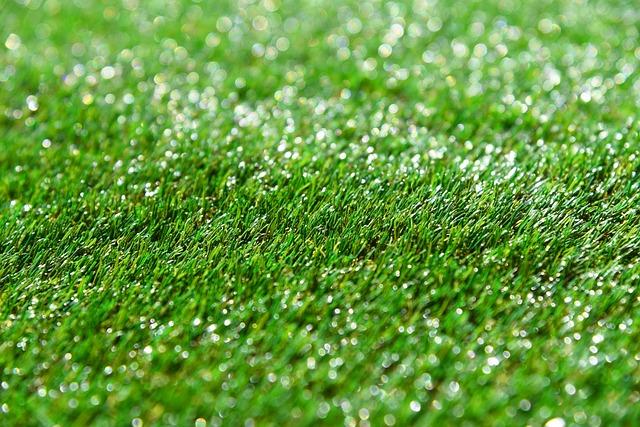Most homeowners have been snowed in and enjoy the benefits that ride cheek-by-jowl with the winter, from a better immune system to more family time. However, all that might change with the sun preparing to take center stage.
One of the significant concerns with the warm weather is the loud rah-rah noise of lawn mowers. Also, watering, fertilizing, weeding, and mowing your natural lawn will likely eat up your family time and increase your expenses.
This explains why there’s an alarming increase in the number of homeowners jumping ships to avoid costly and constant maintenance. The beautiful ever-green appearance, reliable drought resistance, and no-chemical requirement of lush grass make it appealing to homeowners looking to spend more time with their families.
So, if you are still dithering, here are a couple of homeowner FAQ questions to help you make an informed decision.
What’s faux grass made of?
Artificial turfs are made of synthetic fibers to mimic natural grass. While it won’t feel exactly like its natural counterpart, the lush grass can look just as beautiful.
The fibers are usually made of polyethylene, which provides soft, green blades (also called yarns) with a sheer resemblance to natural ones. The faux grass blade features UV inhibitors to prevent them from fading or losing its softness due to prolonged exposure to sunlight.
Thus, it ensures your lawn retains a green, healthy look even during drought or when others in your community run low on water. Also, the yarns can come with stabilizers to keep the blade standing tall and stand up to constant trampling.
How durable are artificial turfs?
If properly installed, including using the correct infill and correctly preparing the site, faux grass can last more than two decades. For regions with extreme sunlight conditions, opting for UV-resistant lush grass is essential to prevent the blades from fading and looking pale. However, the drainage must be well-installed to avoid standing water or puddling if you live in areas with all-year rainfall.
Most importantly, consider hiring the best company, like OC Turf and Putting Greens, artificial grass installer in Laguna Niguel, for the job to avoid any complications. The durability of the synthetic grass can boil down to how it’s being installed.
Is faux grass pet-friendly?
One of the benefits of owning a lawn is to create enough space for your furry family to play and do their business. Luckily, the artificial counterpart is a better alternative to natural grass.
You don’t have to struggle to wash off their poop or urine with fake grass. It has a gravel base which their urine seeps into and drains away without staining or damaging the lush lawn. Also, you might wonder if your curious furry animals won’t chew or dig the fake lawn. So, it’s vital to consider turf options designed for households with pets.
These pet-friendly turfs make it easier to scoop the solid waste of your pets from the lawn, which keeps it hygienic and pristine.
Another benefit of using a fake lawn instead is its chemical-free maintenance, which eliminates any safety concerns. Your furry pals can play as long as you want and in whatever way, they prefer without coming into contact with hazardous substances.
How hard is installing fake grass?
This is one of the misconceptions about turfs. Installing these artificial alternatives is a breeze and won’t take more than three days to complete the process. However, it might require you to get a helping hand to ease the process.
But for people who hate to get their hands dirty, it might be best to seek a professional artificial grass installer. However, it’s doable if you are a DIY-kind-of-person 一 just follow the instructions or watch an online tutorial for visual guidelines.
Is turf sustainable?
Fake grass can be the way to go if you want to minimize your footprint. The fact that turfs can reduce water consumption makes it an eco-friendly option. It’s a decent choice, especially if you live in areas with strict government water regulations.
In addition to that, artificial grass won’t grow or turn into a mess that would require a fossil-fuel lawnmower to clear it up. Also, you won’t have to use harmful chemicals, either as herbicides or fertilizers, that wash off and pollute other ecological habitats nearby.
Can you install artificial turf on concrete?
In most cases, turfs are installed in areas where you have natural grass as a replacement. However, it’s not the only ideal spot for artificial grass.
This faux option works well in many places, including an abandoned driveway, concrete patio, and many more.
But when installing turfs on concrete or other floorings, it’s essential to use an adhesive to ensure the turf is securely held in place. Even better, you cover an area with fake grass and create little soft underfoot spots to bear striking resemblances to a little lawn.
Do faux grasses get hot?
Artificial grass has come a long way. Newer options are nothing like their predecessors that tend to absorb sunlight and heat, causing them to be uncomfortable to step on. Also, it depends on the type of thought you are installing.
High-quality turf should be resilient enough to withstand warping and stretch under any condition. Some types of fake grass have nearly the same temperature as natural glass under the same conditions. In some instances, you might even find synthetic grass is much cooler than real ones.
Is synthetic grass cost-effective?
Replacing your natural lawn with the synthetic counterpart requires an expensive upfront cost. But over time, the ZERO maintenance cost makes artificial turfs cheaper than the very ones.
Natural lawns need you to mow, weed, fertilizer, insecticides, and much more, which won’t come cheap.
The cost of installing natural grass might seem reasonable at first. In the long run, the cost of maintenance might leave you regretful and wishing you went the other way.
Besides, it demands much attention, and you might have to sacrifice your family time to tend to the lawn.
